The garage on the site can be done in different ways. Someone prefers to equip it in the house, someone builds a separate box, someone builds a shed. Each option has its own pros and cons. To choose the best one for yourself, you need to evaluate all the factors.
Pros and cons of a garage in the house
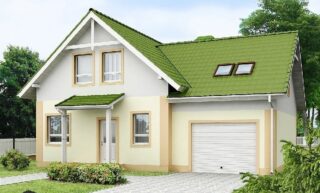
A garage in a private house can be of 2 types: attached and located directly in the building. Despite the similarities, these are different buildings and have different advantages and disadvantages.
The built-in garage is part of the building. It stands on a common foundation with the house and shares a roof with it. The room is heated by heating the residential part. The hood here acts as a general ventilation element, it is much easier to conduct electricity or other communications here.
Distinguish between a basement and an overground garage in the house.
- Basement - a place for a car is a basement or semi-basement room. This option does not reduce the area of the first floor. However, to descend here, you need to make a staircase to ensure the exit of the car - to build an extended ramp under a slope, which will not be cheap.
- Above ground - built into the 1st floor. It is much easier to maintain a normal temperature and humidity regime here. To maintain the optimal temperature for the car, you do not need to heat the garage box itself. For check-in, you do not need to equip a special platform with an inclination, the owner does not need to go down the stairs.
The garage is a source of unpleasant odors and noises. In addition, this room is fire hazardous. Regardless of how it is finished and what kind of insulation is chosen, it is recommended to equip not residential, but technical premises, like a storeroom, terrace, gym.
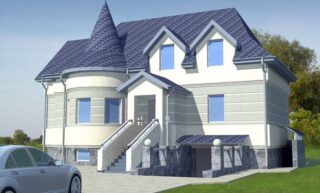
The advantages of this type of placement are many:
- Stable temperature and humidity. The mode is maintained by heating and ventilating the entire building and does not require any costs.
- If the garage is in the house, the owner does not end up outside in bad weather.
- In such a box, it is much easier to organize a home workshop, store bicycles, sports and children's equipment.
- Often, such a project is combined with a boiler room, with other utility rooms.
- The car is essentially kept in the house. And here the security system is better than on the site.
- There is no need to find a place for parking and crossings on the site. This is not so easy, since the garage box must be installed taking into account many SNiP rules.
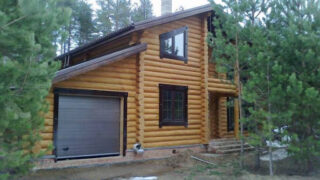
There are also arguments against:
- The garage space is classified as fire hazardous. Oil, fuel and additional materials are stored here. The garage, combined with a residential building, is equipped with a fire alarm and fire extinguishers.
- It is imperative to install a separate hood, since exhaust gases must not enter the house.
- Rooms near the car storage area need additional noise insulation, which increases costs.
- The optimum humidity for storing a car is 50–80%. In a residential building, it is often higher, which increases the risk of corrosion.
The garage box is blocked by a large gate. When opened, a large amount of cold air enters the house. In cold regions, the room becomes a "weak link" and loses a lot of heat.
Garage as an extension to the house
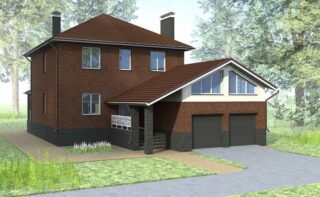
A modern attached garage in a private house is a building that stands on its own foundation. One of the walls becomes for a residential building and an attached common one, but only serves as a supporting structure. The building has its own roof, even the entrance to the house through the garage is optional.
The garage attached to the house has its pros and cons. They differ from the advantages of a built-in room:
- Such a box is not just a separate room, but a separate building. The risk of exhaust gases and unpleasant odors entering the house is much less.
- It is not required to equip additional noise insulation, especially if the garage is connected to the residential part of the building.
- The fire hazard is also reduced.
This option has all the other advantages of the built-in one. It has fewer disadvantages:
- A garage together with a residential building occupies a larger area than a built-in one, but less than a detached one.
- If there is no transition from the box to the residential part of the house, the owner will have to go outside in bad weather to get to the house and bring purchases.
Although the extension has its own roof and does not need a beautiful cladding, in fact, you will have to use the same materials as for decorating the house. Otherwise, the residential complex will look sloppy.
Features of a garage under a canopy
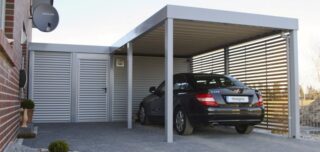
A canopy is a light, simple structure. Most often it is a frame structure, lined with lightweight roofing material and installed on metal or wooden supports. In summer cottages, the canopy often plays the role of a "summer" garage. It protects cars from rain, overheating and direct sunlight. This makes parking the car much easier, since the location of the carport is not regulated as strictly as the garage box.
This option has many advantages:
- First of all, the low price attracts. The construction of a canopy will cost much less than the construction of a capital structure with walls.
- Installation takes 2-3 days. A beginner can also handle work with his own hands.
- The canopy is easy to dismantle and move to any other place. It's just as easy to resize.
- The design does not clutter up the site. Does not impede access to the vehicle and does not limit its size.
- The canopy can serve as an excellent resting area.
- The car is well ventilated under the shed, which reduces the risk of corrosion.
Disadvantages of the design:
- The canopy protects against direct rays and normal rain, but becomes ineffective in oblique rain or high winds.
- Does not protect against cold and snow.
- There is no way to store tools and maintenance materials here. They will have to be stored in a pantry or shed.
- If the site is with a slope, the area under the canopy must first be leveled.
- The machine becomes covered with dust when stored in this manner.
In the northern regions, you cannot leave the car under a shed for the winter.
Pros and cons of a detached garage
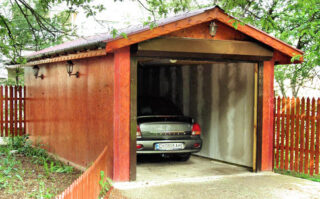
A garage, standing separately from the house, can be either a capital structure made of brick, concrete, or a light one, without a foundation - a metal box. The location of the first is regulated by SNiP, the second can be placed anywhere on the site.
This option is practical for the following reasons:
- for the construction of a detached building, there is no need to use the same expensive materials for roofing and decoration as for a residential building;
- you can place a garage right outside the gate, that is, a car from the street goes straight into the box;
- no additional sound insulation or extractor hood is required to prevent odors and dirt from entering the house;
- the overall fire safety decreases.
There are many disadvantages:
- even a small building takes up space on the site;
- placement is regulated by SNiP, this imposes many restrictions;
- the cost of a garage next to a private house is higher if we are not talking about a metal box;
- at least electricity must be laid to the building, if heating is needed, then the costs will be even greater;
- it is necessary to organize an entrance to the garage, which is also not always easy.
The garage should not be placed in the garden away from home. It is not comfortable. On the other hand, if the building is in plain sight, its design should at least to some extent correspond to the design of a residential building.
Criterias of choice

Basic recommendations for choosing:
- If you need to save every ten meters, a built-in basement garage is the best solution.
- The larger the vehicle, the less suitable it is for storage within the home. If the owner of the cottage drives a minibus, it is better to build a free-standing box.
- If the room is also used as a car workshop, choose a free-standing structure or at least an attached one. Otherwise, the cost of soundproofing will be huge.
- If the house is used only in the warm season, a shed is built.
The design of the garage - free-standing, shed, attached - is chosen taking into account many factors. Any solution has pros and cons, but it is important to choose the best one for specific conditions.








